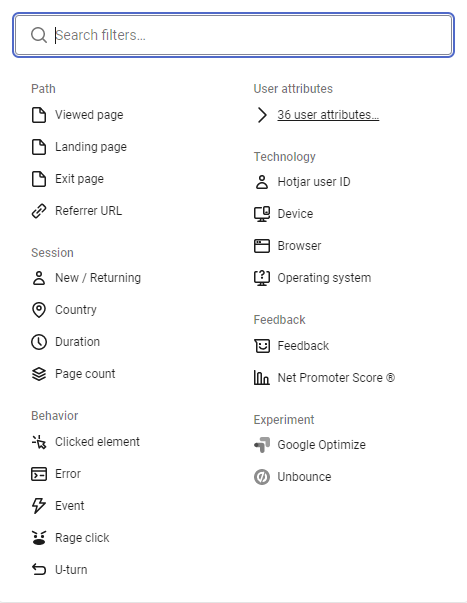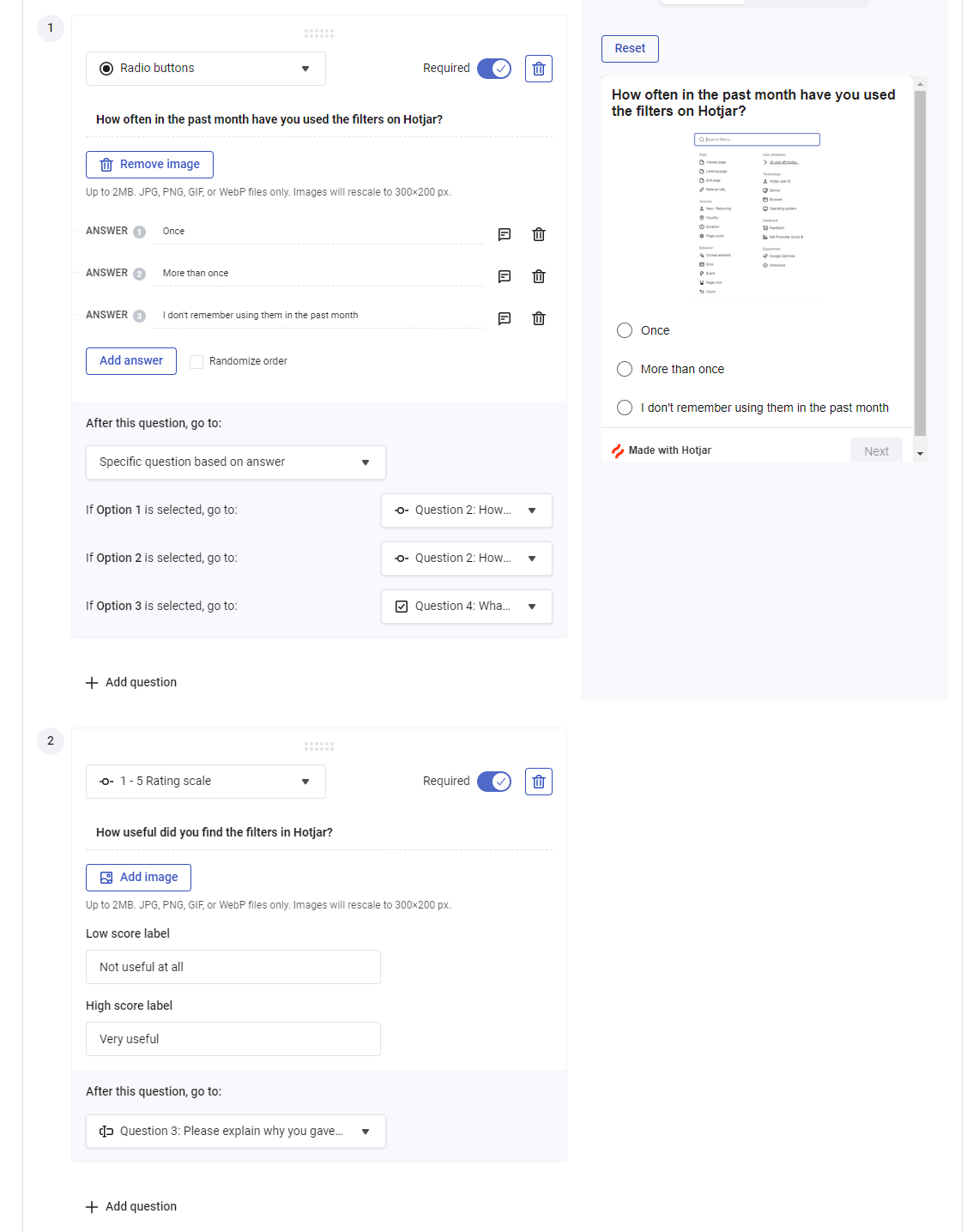Global filters and segments
The context:
This case study covers a research project I led at Hotjar, focused on what we called “global filters”—filters that apply across all areas of the platform. It also tackled a long-standing internal terminology debate: is “segments” the right term to use for saved filters?
The team:
Researcher/Content designer (me) - leading, Product design - supporting
At Hotjar, I was part of the Dashboard team, which also owned Global filters and Segments. Previous research had shown that users often felt overwhelmed by the number of filters available and unsure of how to use them effectively. We knew we needed to dig deeper to understand how to simplify and improve the experience.
Around that time, I took part in a workshop where I proposed letting users define the filter categories that made the most sense to them, since our existing categories weren’t research-backed. The assumption was that by grouping our numerous filters into categories relevant to our users, we would increase their adoption. The idea was well received and became the foundation for the research on Global filters and Segments that I went on to lead.
The process:
I began by summarizing our objectives and hypothesis, then aligned with the team to ensure nothing was missing.
There were two main points we wanted to address via this research: making global filters less overhwleming and more intuitive, and validating whether "segments" was the right terminology for saved filters.
Next, I considered which research methodology would best address our hypotheses and questions.
Based on my previous experience, I chose card sorting as the most effective way to understand how participants categorize concepts. To maximize insights, I decided to conduct two separate card sorting exercises: one moderated and one unmoderated. The moderated sessions would help us uncover the reasoning behind participants’ groupings, while the unmoderated sessions would serve to validate those findings.
I set up both card sorting experices on Optimal workshop, and simultaneously started organizing the moderated interviews with Hotjar customers.
I recruited the particiapants for the moderated interviews using Hotjar’s internal usability testing platform, Engage. I then ran all of the interviews myself, with the Product desiger helping me with note-taking.
Part of the Hotjar survey I created to invite users to participate in the unmoderated card sorting
For the unmoderated tests, I set up a survey on Hotjar inviting users to participate in the unmoderated card sort.
The survey modal appeared only when a user interacted with the “Add filter” button anywhere within the platform, ensuring that participants had used filters at least once—a key requirement for the study.
Following the completion of both moderated and unmoderated tests, I analyzed the results and put together a report with findings and next steps.
The findings showed that almost 73% of participants use filters almost every time they analyze data in Hotjar. However, they tended to use only a handful of the many available filters because they weren’t sure about the purpose of the rest or how they could benefit from them. I also compiled a list of the most used filters, and how they better addressed our customers’ needs.
Some of the quotes where participants talk about the filters they use, and don’t use
We also discovered confusion around the meaning of certain filters, both existing and upcoming. For example, “Page count” and “Error” were among the most unclear filter names. For instance, “Error” did not specify whether it referred to system errors or user errors, leading to uncertainty.
These insights was especially valuable to me, as they directly related to my role as a Content designer and highlighted an area where I could make meaningful improvements.
A participant sorting the filters into categories
When it came to the categories participants had created, I created a summary of the category labels and the type of terms used within them. For example, over 80% created a category containing the word ‘‘user’’ (e.g. User behavior, User actions, etc.)
On the other hand, only 15% created a category related to user journeys, using terms like ‘‘path’’ and ‘‘journey’’. This was particularly interesting as Hotjar’s Global filters already included a category called ‘‘Path’’. This showed a clear disconnect between the langauge we used and that of our customers.
To better understand the groupings, I generated similarity matrixes for both the moderated and unmoderated cards sorts. Based on those, I was able to create a list of recommended groupings and categories, entirely informed by our participants’ feedback.
Next, it was on to the long-standing internal terminology debate I mentioned at the beginning. I wanted to understand if the term ''segments'' resonated with our users, and if replacing it with a simpler term like “saved filters” would improve adoption.
The research confirmed the hypothesis: users were generally unaware that saving two or more filters creates a segment they can reuse later.
The way I arrived at this insight was a simple content test. After completing the card sort, I gave participants a list of terms and asked them to choose one that best describes a group of filters you save for quick access the next time they log in. The options were: Segment, Saved filters, Quick filters, Something else.
‘‘Save filter’’ came on top as the prefered term. Participants found it the most intuitive and felt it accurately reflected something they had created themselves, rather than a system-generated category.
Result of the poll asking participants to select their preferred term
The result:
Shortly after the study was completed, company priorities shifted significantly following the acquisition of Hotjar, and the changes it introduced. As a result, acting on the research findings was put on hold but they ultimately proved valuable later on:
As part of the study, we tested terminology for upcoming global filters. The findings directly informed the naming and descriptions used in the final release.
The study also supported a parallel project focused on introducing Global segments, and improving their discoverability. I used the insights to advocate for clearer education around the value of segments.
The study was referred to often and by multiple teams when we started working on merging Hotjar's filters and segments with those of Contentsquare (the company that acquired Hotjar). It helped inform the terminology used in Contentsquare’s updated filtering experience.







